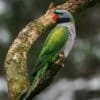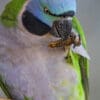Derbyan Parakeet
Also known as:
Lord Derby's Parakeet, Derby's Parakeet
Also known as:
Lord Derby's Parakeet, Derby's Parakeet
DID YOU KNOW?
The Asiatic or Asian Parakeets have tails that are just as long or longer than the length of their bodies.

Psittacula

derbiana
Size:
50 cm (19.5 in)
Weight:
320 g (11.2 oz)
Subspecies including nominate:
one
Colour Adult:
Male-black lower cheeks and forehead stripe extending to eyes; forecrown washed bright blue, becoming blue/green around eyes; rest of head blue/purple; upperparts green; area from throat to lower abdomen lilac/purple; inner middle and secondary wing coverts dull green/yellow forming patch on wing when folded; tail blue tinged with green near base; upper mandible red, lower black. Eye pale yellow. Female-blue on forecrown absent; throat to lower abdomen area duller grey/violet; pink stripe from behind lower cheeks up to hindcrown, black lower cheeks; shorter tail. Beak black.
Colour Juvenile:
Head and throat areas to lower abdomen grey/green, with some feathers margined dull purple/blue; black facial markings more grey; tail short. Beak orange. Eye grey.
Call:
Calls in flight are raucous, loud, and metallic-sounding, resembling crows and ravens. Contact calls carry some distance.
More Information:
Content Sources:
CITES
BirdLife International
Cornell Lab of Ornithology/Birds of the World
Parrots: A Guide to Parrots of the World, Juniper and Parr, 1998
Parrots of the World, Forshaw and Cooper, 1977. 2010 edition
Parrots of the World, Forshaw, 2006.
Parrots in Aviculture, Low, 1992.
Lexicon of Parrots, Thomas Arndt.
Parrots: Their Care and Breeding, Low, 1986.
J. Eaton in litt. 2010, Zeidler and Francis 2011.
Captive Status:
Uncommon; limited breeding.
Longevity:
15-20 yrs
Housing:
Walk-in aviary, minimum length 4.5 m (14.7 ft), built without wood.
Diet:
Fruit such as: apple, pear, orange, banana, pomegranate, cactus fruits, etc, forming about 30 percent of the diet; vegetables such as: carrot, celery, green peas and beans, corn; green leaves such as: Swiss chard, lettuce, sowthistle, dandelion, chickweed; spray millet; small seed mix with canary, millet and smaller amounts of oats, buckwheat and safflower; limited sunflower seed soaked or sprouted; cooked beans and pulses and complete kibble.
Enrichment:
Provide lots of bird safe chew items (branches, sterilized pine cones, fir, pine, vegetable tanned leather toys). Provide shallow bathing dish.
Nest Box Size:
Nest and roosting log with 10″ (25.4 cm) internal diameter and 24″ (61 cm) height.
Clutch Size:
2 to 4
Fledging Age:
7-8 weeks
Hatch Weight:
—
Peak Weight:
—
Weaning Weight:
—
World Population:
Unknown but reported as fairly common. Decreases are moderately rapid.
IUCN Red List Status:
Least Concern
CITES Listing:
Appendix II
Threat Summary:
Not globally threatened. Apparently fairly common within its relatively undisturbed range; recorded as usually occurring in large flocks. The species was formerly threatened by the loss of breeding habitat; however, this eased in the 1990s, but old-growth trees are still used for housing and firewood. Is disappearing from some areas and subject to locally heavy cagebird trade and is thus suspected to be experiencing a moderately rapid decline.
Range:
E Himalayas and Tibetan Plateau, from Arunachal Pradesh, NE India, and SE Tibet, east in Tsangpo River valley, to SW China in SE Xizang, SW Sichuan and W Yunnan. Isolated group 50km from Simao, Yunnan, S China.
Habitat:
Found in highland forest from 2700-4000 m (8856-13,120 ft). Seen in coniferous or mixed Pinus and Quercus forest, also from alpine Rhododendron growth areas. Also reported in cultivated valleys at harvest.
Wild Diet:
Feeds on seeds of Pinus tabulaeformis, catkins of Populus ciliata, pine cones and cultivated fruits and grain.
Ecology and Behaviour:
Gregarious; found in noisy, boisterous flocks of up to several dozen individuals. Rarely seen in pairs or singles.
Clutch and Egg Size:
2 to 4 eggs, 36.0 x 27.5 mm (1.4 x 1.1 in)
Breeding Season:
June. Nest is in tree cavity, often Populus ciliata; also seen in sand tunnels, presumably in high riverbanks.
Related Links:
—
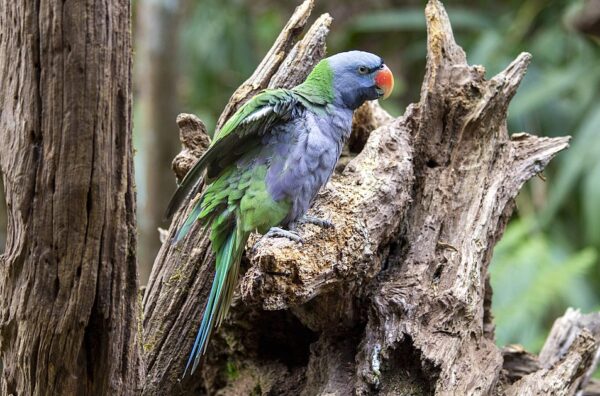
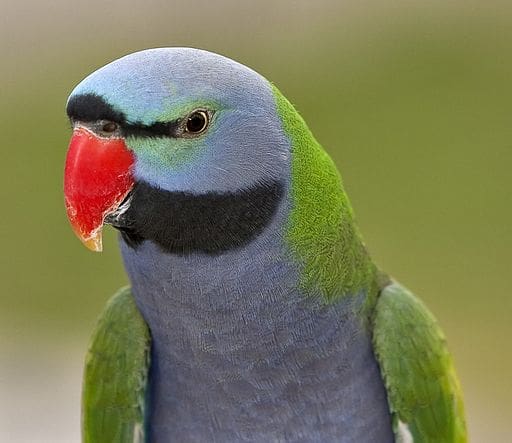
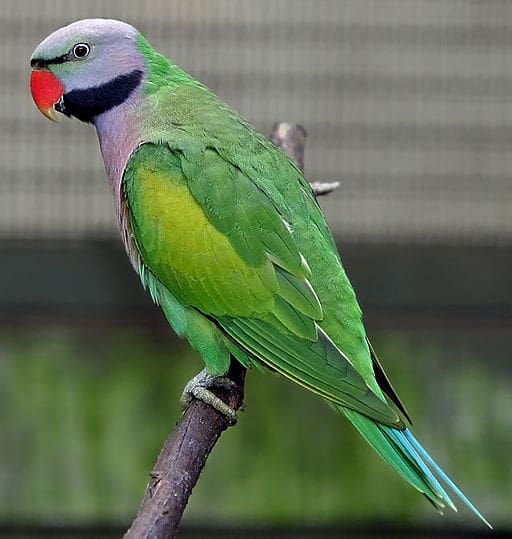
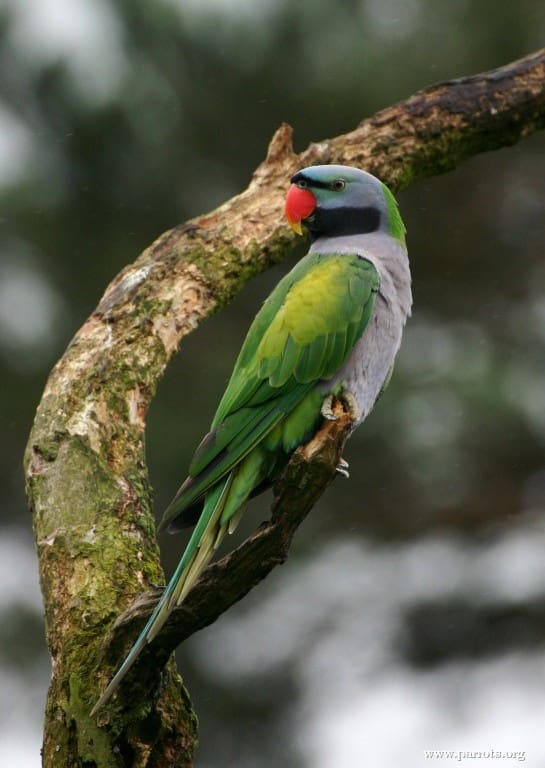
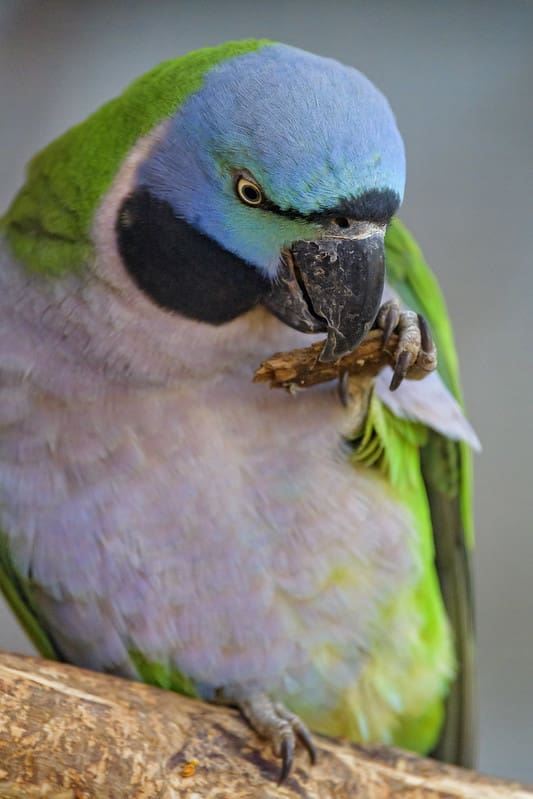
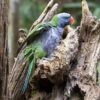
![© Doug Janson (Own work) [CC BY-SA 3.0 or GFDL] via Wikimedia Commons A closeup of a companion Derbyan Parakeet](https://parrots.org/wp-content/uploads/2023/01/wpt_Derbyan-Parakeet_1286-3-100x100.jpg)
![© Doug Janson (Own work) [CC BY-SA 3.0 or GFDL] via Wikimedia Commons A male Derbyan Parakeet perches on a branch](https://parrots.org/wp-content/uploads/2023/01/wpt_Derbyan-Parakeet_1286-2-100x100.jpg)
